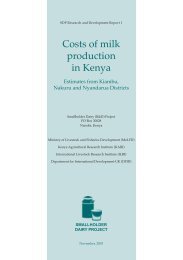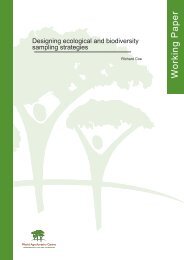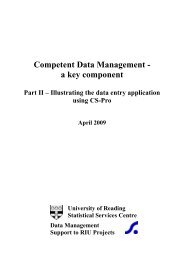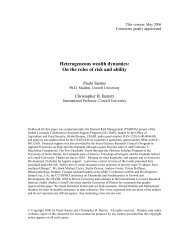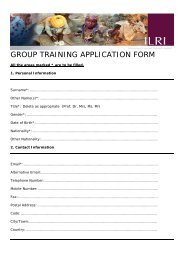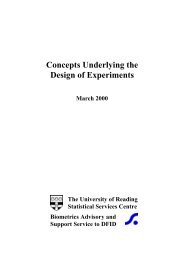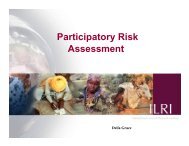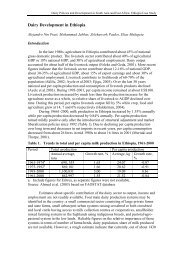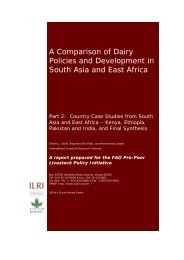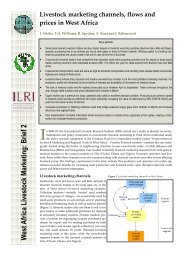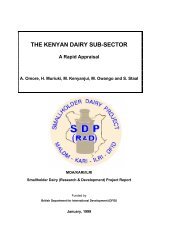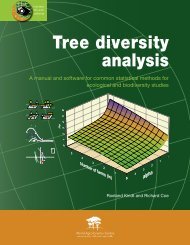Improvement of Livestock Production in Crop-Animal Systems in ...
Improvement of Livestock Production in Crop-Animal Systems in ...
Improvement of Livestock Production in Crop-Animal Systems in ...
You also want an ePaper? Increase the reach of your titles
YUMPU automatically turns print PDFs into web optimized ePapers that Google loves.
duck production systems. Most ducks are released on ponds dur<strong>in</strong>g the day and penned at night, where theyare fed with limited amounts <strong>of</strong> concentrates. Ducks are kept for two lay<strong>in</strong>g seasons <strong>in</strong> which they produceabout 150–180 eggs.Feed resourcesThe feed resources <strong>in</strong> Cambodia <strong>in</strong>clude relatively small areas <strong>of</strong> native grasslands (about 315,000 ha);herbage from roadsides, wasteland and rice stubble; crop residues, broken rice and agro-<strong>in</strong>dustrialby-products (AIBP) (rice bran, soyabean and fish meals). The largest grasslands are found <strong>in</strong> Kompong ThomProv<strong>in</strong>ce (99,000 ha), where the carry<strong>in</strong>g capacity is about 2.5 adult oxen per ha. Most <strong>of</strong> the AIBP areexported to neighbour<strong>in</strong>g countries at the expense <strong>of</strong> pig and poultry production. The availability <strong>of</strong> rice strawis <strong>in</strong>fluenced by variety (IRRI cultivars are short-straw types unlike the traditional long-straw Cambodianvarieties), and by harvest method (straw is cut relatively close to ground level). In addition, hand-harvest<strong>in</strong>gtakes place over a long period, so that some <strong>of</strong> the early material has decayed by the time animals are allowedto graze the stubble.Graz<strong>in</strong>g for rum<strong>in</strong>ants is severely limited <strong>in</strong> the dry season. The onset <strong>of</strong> the ra<strong>in</strong>s <strong>in</strong>creases mortalitydue to the release <strong>of</strong> large numbers <strong>of</strong> nematode larvae. The onset <strong>of</strong> the wet season also floods much <strong>of</strong> thearea which, together with the areas brought under cultivation, reduces the availability <strong>of</strong> herbage. In the dryseason, both pasture and rice straw are <strong>of</strong> low nutritive value, particularly <strong>in</strong> terms <strong>of</strong> digestibility and prote<strong>in</strong>.M<strong>in</strong>eral deficiencies, which have not been accurately assessed, may also be a constra<strong>in</strong>t. Very littlesupplementation is practised although limited efforts have been made to treat rice straw with urea. Thecultivation and use <strong>of</strong> legum<strong>in</strong>ous forages is m<strong>in</strong>imal.<strong>Animal</strong> health and diseasesTable A1 summarises the most important diseases <strong>of</strong> animals already identified <strong>in</strong> Cambodia. The mostimportant diseases <strong>in</strong> large rum<strong>in</strong>ants <strong>in</strong> smallholder systems are foot-and-mouth disease and haemorrhagicsepticaemia. These diseases are extremely important for farmers depend<strong>in</strong>g on draft animal power for landpreparation and haulage. The annual morbidity and mortality rates are very high <strong>in</strong> all species. Mortality ratesfor calves and adult large rum<strong>in</strong>ants are 10–20% and 4–8%, respectively. Buffaloes generally show betterbody condition than cattle. Although buffaloes are better adapted to poor nutritional regimes, they are moresusceptible to haemorrhagic septicaemia and the mortality rates <strong>of</strong> their calves is thought to be higher than<strong>of</strong> cattle, which may be a result <strong>of</strong> greater susceptibility to <strong>in</strong>ternal parasites particularly Neoascaris spp. Theloss <strong>of</strong> body weight and outbreaks <strong>of</strong> disease <strong>of</strong>ten occur dur<strong>in</strong>g the late dry season and at the start <strong>of</strong> thera<strong>in</strong>s, when animals are required for land preparation. About 30–40% <strong>of</strong> pigs purchased at wean<strong>in</strong>g fortether<strong>in</strong>g die with<strong>in</strong> six weeks. Some 80–90% <strong>of</strong> young chicken and 50% <strong>of</strong> adult birds die from diseasessuch as Newcastle disease.Currently, farmers have little access to veter<strong>in</strong>ary <strong>in</strong>puts and services. Haemorrhagic septicaemiavacc<strong>in</strong>e for large rum<strong>in</strong>ants, which gives up to 12 months protection, is the only one produced locally by theDepartment <strong>of</strong> <strong>Animal</strong> Health and <strong>Production</strong> (DAHP) <strong>in</strong> Phnom Penh. This vacc<strong>in</strong>e forms part <strong>of</strong> the regularvacc<strong>in</strong>ation programme <strong>of</strong> the DAHP. However, the majority <strong>of</strong> animals receive the vacc<strong>in</strong>ation only once<strong>in</strong> a lifetime without any booster vacc<strong>in</strong>ations. Another factor associated with the problem <strong>of</strong> diseases is theillegal movement <strong>of</strong> animals across the borders <strong>of</strong> the country. This movement is massive and uncontrolledand requires government <strong>in</strong>tervention.Socio-economic aspectsFour socio-economic surveys <strong>of</strong> agriculture have been undertaken at different times by different agencies.These have been largely <strong>of</strong> a diagnostic nature, with limited follow-up <strong>in</strong>terventions. Those with specificreference to animals have been undertaken ma<strong>in</strong>ly by NGOs and, to a lesser extent, by the German Agencyfor Technical Co-operation (GTZ) and IRRI. The International Development Research Centre (IDRC) isabout to <strong>in</strong>itiate a six-month farm<strong>in</strong>g systems survey to <strong>in</strong>clude animals <strong>in</strong> the context <strong>of</strong> natural resourcemanagement, community-based management <strong>of</strong> animals and resource allocation. The contribution <strong>of</strong> animals



